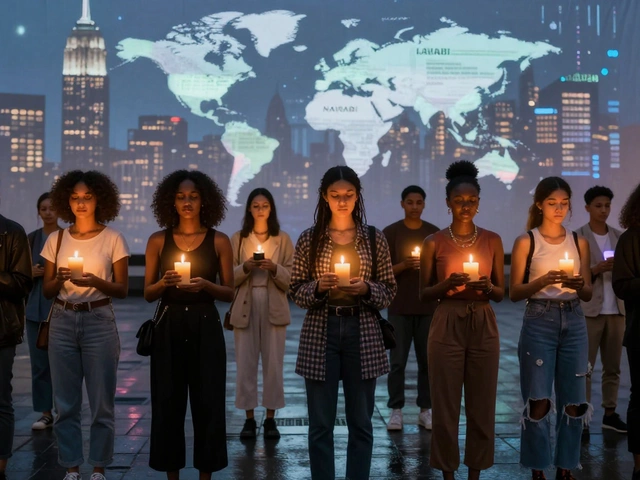Apple Unveils Vision Pro 2 in London, Aiming to Redefine Mixed Reality
When Tim Cook, CEO of Apple Inc. stepped onto the stage in London on October 24, 2025, the room fell into a hush that felt more like anticipation than applause. The headline? Apple’s first mixed‑reality headset, the Vision Pro 2, is now officially on the market – and it’s priced at $2,299, a $400 jump from the original.
Apple announced the device during a sleek, 90‑minute spectacle dubbed the Apple Vision Pro 2 Launch EventLondon. Attendees wore the new headset to experience a demo that blended a virtual newsroom with a real‑world café, showing off the rumored 8K per eye display and a new custom silicon chip that Apple calls the ‘M3 XR’. The twist is, Apple claims the device now tracks eye movement with 99.9% accuracy, a figure that’s already sparking debate among developers.
Background: Apple’s Long Road to Mixed Reality
Apple first hinted at a mixed‑reality foray back in 2020, when it filed a series of patents for “foveated rendering” and “spatial audio integration”. The original Vision Pro, launched in early 2023, was praised for its design but criticized for its steep $3,499 price tag and limited app ecosystem. Yet the company kept plugging away, acquiring several AR startups – most notably MetaVR in 2022 – and rolling out a developer kit that saw over 400,000 downloads by the end of 2024.
Industry observers say the Vision Pro 2 is Apple’s answer to the under‑whelming sales of its first headset and the aggressive push from Meta’s Quest 4, which launched at $499 a year ago and has already captured 12 million units worldwide. The fact that Apple chose London – home to a thriving AR developer community – instead of its usual Cupertino press room underscores a strategic pivot toward a more global developer base.
Inside the Vision Pro 2: Specs, Design, and New Features
Let’s break down what’s inside the sleek aluminum frame. First up, the display: two micro‑OLED panels delivering 8K resolution per eye, a 30% brightness increase over the original, and a refresh rate that peaks at 120 Hz. The headset is also lighter by 50 grams thanks to a new carbon‑fiber lattice that Apple says reduces fatigue during marathon sessions.
- Processor: Apple‑designed M3 XR chip, 6‑core CPU, 16‑core GPU, and a dedicated neural engine for real‑time scene analysis.
- Battery life: Up to 4 hours of continuous mixed‑reality use, with a magnetic charger that snaps onto the front of the device.
- Audio: Spatial audio with dynamic head‑tracking, powered by custom‑tuned drivers that adapt to the wearer’s ear shape.
- Tracking: Six outward‑facing cameras, three infrared sensors, and a LiDAR scanner for precise environment mapping.
One surprise is the new “Hand‑Free Mode”, which lets users navigate menus with subtle facial gestures – a feature that Apple demonstrated by having a presenter open Safari, type a URL using just eye‑movement, and then swipe away a virtual ad with a quick eyebrow raise. It's the sort of futuristic flair that makes you forget you’re still watching a product launch.
Industry Reactions: Competitors, Developers, and Analysts Weigh In
Meta’s chief AR officer, Andrew Bosworth, issued a brief statement on the day of the launch: “We welcome Apple’s continued investment in mixed reality. Competition drives innovation, and we’re already planning a software update to bridge the gap for Quest 4 users.” The comment, while diplomatic, hinted at a possible price‑cut rumor that’s already circulating in tech forums.
Developers seem split. “The M3 XR is a game‑changer,” says Leila Gupta, senior AR engineer at London‑based startup HoloWorks. “Apple’s SDK now supports native Unity integration, which means we can port games three times faster than before.” Meanwhile, independent creator Mike Donovan worries about the $2,299 price barrier, noting that “the average indie app budget can’t accommodate a headset that costs more than many of our development tools.”
Analysts at Bloomberg Intelligence downgraded Apple’s mixed‑reality revenue outlook by $1.2 billion for 2026, citing the higher price point but also acknowledging that early‑adopter sales could exceed 1 million units if the developer ecosystem expands quickly.

Impact on Consumers: What the Vision Pro 2 Means for Everyday Use
For most consumers, the Vision Pro 2 isn’t just a gadget; it promises a new way to work, learn, and play. Apple’s “Spatial Office” demo showed a virtual conference room where participants could pull up 3D models of product prototypes, annotate them in real time, and switch to a private “focus mode” that blocks out digital distractions. In education, Apple partnered with the University of Oxford to create a virtual lecture hall that can seat 500 students, each with a personalized view of a digital blackboard.
But the device’s battery life and the steep price still raise eyebrows. A survey by the Consumer Technology Association found that 68 % of respondents would consider buying a mixed‑reality headset only if it cost under $1,500. Apple’s answer? A financing plan that spreads the cost over 24 months with 0 % interest, plus a trade‑in program for older Apple devices.
Privacy advocates are also watching closely. The headset’s eye‑tracking data is stored locally, but Apple’s privacy policy mentions that anonymized usage data may be sent to its cloud for “machine‑learning improvements”. Shoshana Zuboff, author of *The Age of Surveillance Capitalism*, warned that “the depth of biometric data captured by headsets like Vision Pro 2 could become a new frontier for data exploitation if not tightly regulated.”
Future Outlook: Updates, Competing Products, and Market Trends
Looking ahead, Apple has already teased a “Vision Pro 3” slated for 2027, promising a sub‑$1,500 price tag and a slimmer design that resembles a pair of sunglasses rather than a bulky visor. Meanwhile, Meta is rumored to be working on a mixed‑reality device that integrates directly with its social platforms, potentially undercutting Apple on price but lacking the premium hardware Apple touts.
What’s clear is that the mixed‑reality market is evolving faster than anyone expected. IDC predicts the global AR/VR market will hit $250 billion by 2028, with Apple and Meta together accounting for nearly 40 % of that revenue. The Vision Pro 2 could be the catalyst that pushes mixed reality from niche labs into mainstream living rooms – if Apple can keep developers happy and price concerns in check.

Key Facts
- Launch date: October 24, 2025, in London
- Price: $2,299 (US), £1,999 (UK)
- Display: 8K per eye, 120 Hz refresh rate
- Processor: Apple M3 XR chip
- Battery life: Up to 4 hours of continuous use
Frequently Asked Questions
How does the Vision Pro 2 differ from the original Vision Pro?
The Vision Pro 2 sports a lighter carbon‑fiber frame, 8K per‑eye displays, a new M3 XR chip, and a battery that lasts up to four hours. It also introduces Hand‑Free Mode, which lets users navigate using facial gestures, a feature absent from the 2023 model.
Will the higher price affect adoption rates?
Analysts expect a price‑sensitive market. A recent Consumer Technology Association poll showed 68 % of potential buyers would only purchase a mixed‑reality headset under $1,500. Apple’s financing options may soften the blow, but price remains a key hurdle for mass adoption.
What does the launch mean for competing companies like Meta?
Meta’s Quest 4, priced at $499, still leads in unit volume. However, Apple’s hardware prestige forces Meta to accelerate its own software innovations and consider price adjustments to stay competitive in the premium segment.
Are there privacy concerns with the Vision Pro 2’s eye‑tracking?
Apple stores raw eye‑tracking data locally and only sends anonymized aggregates to its cloud for improvement. Critics argue that even de‑identified biometric data could be misused, urging stricter regulations on how such data is handled.
When can we expect a lower‑priced version of Apple’s mixed‑reality headset?
Apple hinted at a Vision Pro 3 slated for 2027, which may launch at a sub‑$1,500 price point. Until then, the Vision Pro 2 remains the flagship model, targeting professionals and early adopters willing to pay a premium for cutting‑edge performance.




